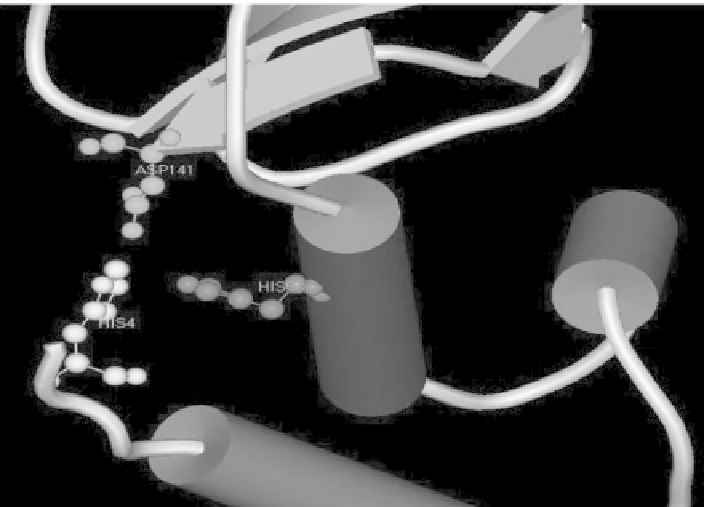Biology Reference
In-Depth Information
Figure 18:
Metal binding sites of predicted MnSOD of
Lyngbya valderian
a BDU20041. Catalytically essential aspartate or histidine
residues are represented in ball and stick mode. Structures are visualized using WebLab ViewerLite 4.2 software [http://
in.msi.com/]. Picture with the kind permission of D. Prabaharan, National Facility for Marine Cyanobacteria (Sponsored by
Department of Biotechnology, Govt. of India), Department of Marine Biotechnology, School of Marine Sciences, Bharathidasan
University, Tiruchirappalli, Tamil Nadu, India. [Priya
et al.
(2010)
Saline Systems
6:
6; doi:10.1186/1746-1448-6-6].
Color image of this figure appears in the color plate section at the end of the topic.
Anacystis nidulans
(but now
S
.
elongatus
PCC 7942) possesses two genes that encode FeSOD. In
order to study the role of Mn-SOD in conferring oxidative stress tolerance, Mn-SOD gene of
E
.
coli
has been subcloned into a
E
.
coli
-
A
.
nidulans
shuttle vector (pSG111) and used in the transformation of
E
.
coli
B101 and
A
.
nidulans
cells. The transformants of both the organisms exhibited increased tolerance
to paraquat-induced oxidative stress suggesting that Mn-SOD provides protection against damage
caused by O
2
•-
anions (Gruber
et al
., 1990). Initial studies were made on the isolation, purifi cation
and localization of Fe- and Mn-SODs in the vegetative cells and heterocysts of cyanobacteria. The
localization of Fe-SOD in the soluble extracts of
A
.
cylindrica
has been demonstrated with the help
of polyclonal antibodies raised against Fe-SOD. The presence of this enzyme in the heterocysts was
shown with the help of immunogold labelling assisted with scanning electron microscopy (Canini
et
al
., 1992). A direct relationship between the levels of these enzymes and the ability to overcome the
oxidative stress response has been established by the studies on the isolation of mutants in certain
cyanobacteria like
P
.
boryanum
affecting Mn-SOD activity (Steinitz
et al
., 1979) and
S
.
elongatus
PCC
7942 defective in Fe-SOD designated as
sodB
-
(Laudenbach
et al
., 1989; Herbert
et al
., 1992).
SodB
-
mutants of
S
.
elongatus
PCC 7942 showed no detectable synthesis of Fe-SOD and the
sodB
locus
exists as a single copy in its genome transcribing a monocistronic mRNA (Laudenbach
et al
., 1989).
This is contrary to the two Fe-SOD gene sequences reported later (Priya
et al
., 2007). Although the
growth rates of both wild-type and the
sodB
-
mutant were similar under normal growth conditions,
the
sodB
-
mutant exhibited increased sensitivity to oxidative stress caused by MV than the wild-type.

